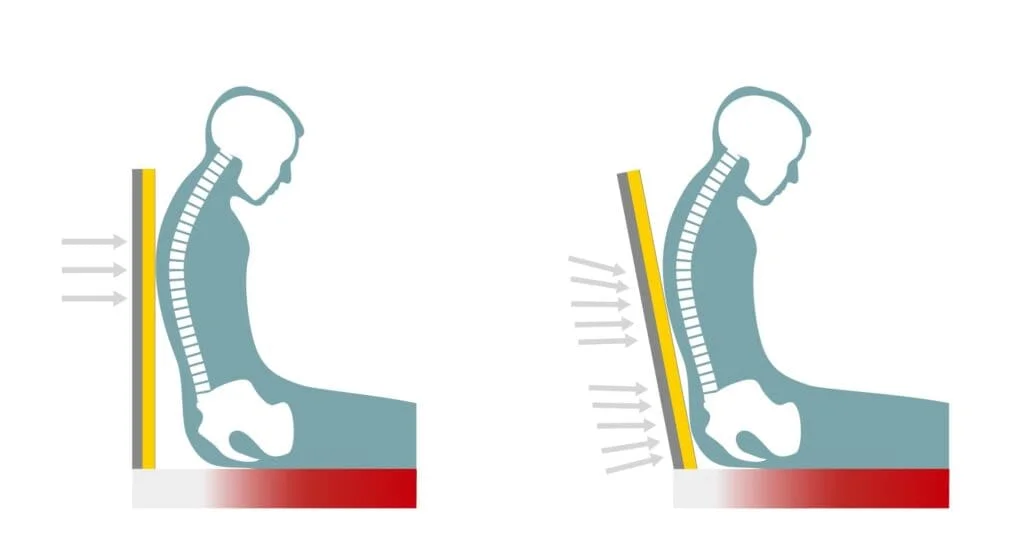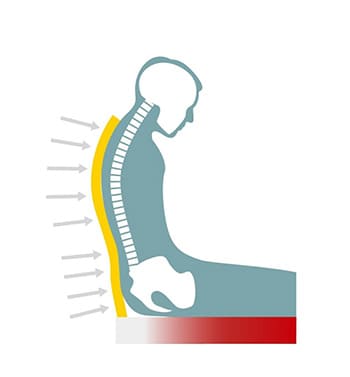Now that the user is sitting in the correct position, what else can you do to help prevent the development of pressure sores?
Wheelchair seat cushions
Over time, the upholstery of the wheelchair can start to stretch, resulting in the hammock effect. The solution to this is to put a hard board/surface on the wheelchair seat with a wheelchair cushion. There are different types of seat cushions to choose from depending on the users budget and sitting requirements.
 |
 |
 |
|
| Wheelchair Cushion Form | Liquid Gel | Interconnected Air Cells | Vicair Air Cushion |
| Ability to Redistribute Pressure | Medium | High | High |
| Stability | Highest | Medium | High |
| Adjustability | Low | High | High |
| Weight | Heavy | Medium | Light |
| Breathability | Low | Medium | High |
| Maintainability | Does not require much maintenance | Needs regular inflation maintenance | Does not require much maintenance |
| Risk of Deflation | Low | High | Low |
Adjustable backrest
Some users with fixed deformities such as kyphosis, will not get the support they need from a standard wheelchair. The below images show what happens when someone with kyphosis sits on a wheelchair with a standard backrest.

Fig. 1. Fig. 2.
If a wheelchair user with kyphosis wants to limit the contact area for pressure sores to occur, they will probably end up compromising a comfortable seating position. They will end up not sitting with their hips positioned all the way to the backrest (Fig. 1). In saying that, if the user does sit with their hips against the backrest (Fig. 2), they increase the contact areas which exposes them to more areas where pressure sores can occur.
The solution is to choose a manual wheelchair with a tension adjustable backrest that can be adjusted to evenly distribute the pressure on the backrest (Fig. 3). Thus, reducing the chance of getting pressure ulcers.

Fig. 3.

Flexx wheelchair is overall, a highly adjustable wheelchair. For example, the backrest has discrete velcro straps that can be used to accommodate a wheelchair user with kyphosis.
Positioning wheelchairs
A positioning wheelchair is the ideal choice for users who can’t walk, sit independently, and/ or have poor neck control. A positioning chair is also ideal for elderly user’s with elderly caregivers, as it takes little effort to reposition the user to distribute their weight.
Tilting the wheelchair reduces the pressure on the hips by shifting the centre of gravity from the hips to the back. Tilting the wheelchair prevents the user from sliding down the seat and risking skin damage. The tilting function allows the user to rest in the wheelchair without having to be moved to a bed. For every hour that an elderly wheelchair is sitting in the wheelchair, we recommend that they are repositioned in the tilted position for 20 minutes.
Reclining the wheelchair will allow the user to lie down and stretch out their hips and lower back. However, when the user returns to the upright position, they might slide forward which in turn will cause them to experience shear force. Occasionally they may also find that the headrest doesn’t align correctly so they need to use a pelvic belt.
A better wheelchair, a better fit
At KARMA, we understand that there is no best wheelchair, only the best fitted wheelchair for each user. Therefore, you should choose a wheelchair that meets the user’s needs to prevent pressure sores, whether it’s a positioning wheelchair or additional wheelchair accessories.
Keep Reading

 Global
Global

